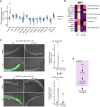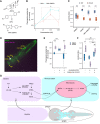The steroid hormone ADIOL promotes learning by reducing neural kynurenic acid levels
- PMID: 38092521
- PMCID: PMC10760639
- DOI: 10.1101/gad.350745.123
The steroid hormone ADIOL promotes learning by reducing neural kynurenic acid levels
Abstract
Reductions in brain kynurenic acid levels, a neuroinhibitory metabolite, improve cognitive function in diverse organisms. Thus, modulation of kynurenic acid levels is thought to have therapeutic potential in a range of brain disorders. Here we report that the steroid 5-androstene 3β, 17β-diol (ADIOL) reduces kynurenic acid levels and promotes associative learning in Caenorhabditis elegans We identify the molecular mechanisms through which ADIOL links peripheral metabolic pathways to neural mechanisms of learning capacity. Moreover, we show that in aged animals, which normally experience rapid cognitive decline, ADIOL improves learning capacity. The molecular mechanisms that underlie the biosynthesis of ADIOL as well as those through which it promotes kynurenic acid reduction are conserved in mammals. Thus, rather than a minor intermediate in the production of sex steroids, ADIOL is an endogenous hormone that potently regulates learning capacity by causing reductions in neural kynurenic acid levels.
Keywords: 5-androstenediol; estrogen receptor β; kynurenic acid; kynurenine pathway; nuclear hormone receptor.
© 2023 Lemieux et al.; Published by Cold Spring Harbor Laboratory Press.
Figures






Similar articles
-
Interaction of Androst-5-ene-3β,17β-diol and 5α-androstane-3β,17β-diol with estrogen and androgen receptors: a combined binding and cell study.J Steroid Biochem Mol Biol. 2013 Sep;137:316-21. doi: 10.1016/j.jsbmb.2013.01.012. Epub 2013 Feb 14. J Steroid Biochem Mol Biol. 2013. PMID: 23416106
-
CYP7B1-mediated metabolism of dehydroepiandrosterone and 5alpha-androstane-3beta,17beta-diol--potential role(s) for estrogen signaling.FEBS J. 2008 Apr;275(8):1778-89. doi: 10.1111/j.1742-4658.2008.06336.x. Epub 2008 Mar 7. FEBS J. 2008. PMID: 18331353
-
Suppression of Delta(5)-androstenediol-induced androgen receptor transactivation by selective steroids in human prostate cancer cells.Proc Natl Acad Sci U S A. 1999 Sep 28;96(20):11173-7. doi: 10.1073/pnas.96.20.11173. Proc Natl Acad Sci U S A. 1999. PMID: 10500149 Free PMC article.
-
Pathways and genes involved in steroid hormone metabolism in male pigs: a review and update.J Steroid Biochem Mol Biol. 2014 Mar;140:44-55. doi: 10.1016/j.jsbmb.2013.11.001. Epub 2013 Nov 12. J Steroid Biochem Mol Biol. 2014. PMID: 24239507 Review.
-
Possibility of Amino Acid Treatment to Prevent the Psychiatric Disorders via Modulation of the Production of Tryptophan Metabolite Kynurenic Acid.Nutrients. 2020 May 13;12(5):1403. doi: 10.3390/nu12051403. Nutrients. 2020. PMID: 32414200 Free PMC article. Review.
Cited by
-
Inhibiting HSD17B8 suppresses the cell proliferation caused by PTEN failure.Sci Rep. 2024 May 29;14(1):12280. doi: 10.1038/s41598-024-63052-5. Sci Rep. 2024. PMID: 38811827 Free PMC article.
References
-
- Agudelo LZ, Femenía T, Orhan F, Porsmyr-Palmertz M, Goiny M, Martinez-Redondo V, Correia JC, Izadi M, Bhat M, Schuppe-Koistinen I, et al. 2014. Skeletal muscle PGC-1α1 modulates kynurenine metabolism and mediates resilience to stress-induced depression. Cell 159: 33–45. 10.1016/j.cell.2014.07.051 - DOI - PubMed
-
- Agudelo LZ, Ferreira DMS, Cervenka I, Bryzgalova G, Dadvar S, Jannig PR, Pettersson-Klein AT, Lakshmikanth T, Sustarsic EG, Porsmyr-Palmertz M, et al. 2018. Kynurenic acid and Gpr35 regulate adipose tissue energy homeostasis and inflammation. Cell Metab 27: 378–392.e5. 10.1016/j.cmet.2018.01.004 - DOI - PubMed
Publication types
MeSH terms
Substances
Grants and funding
LinkOut - more resources
Full Text Sources
Research Materials
